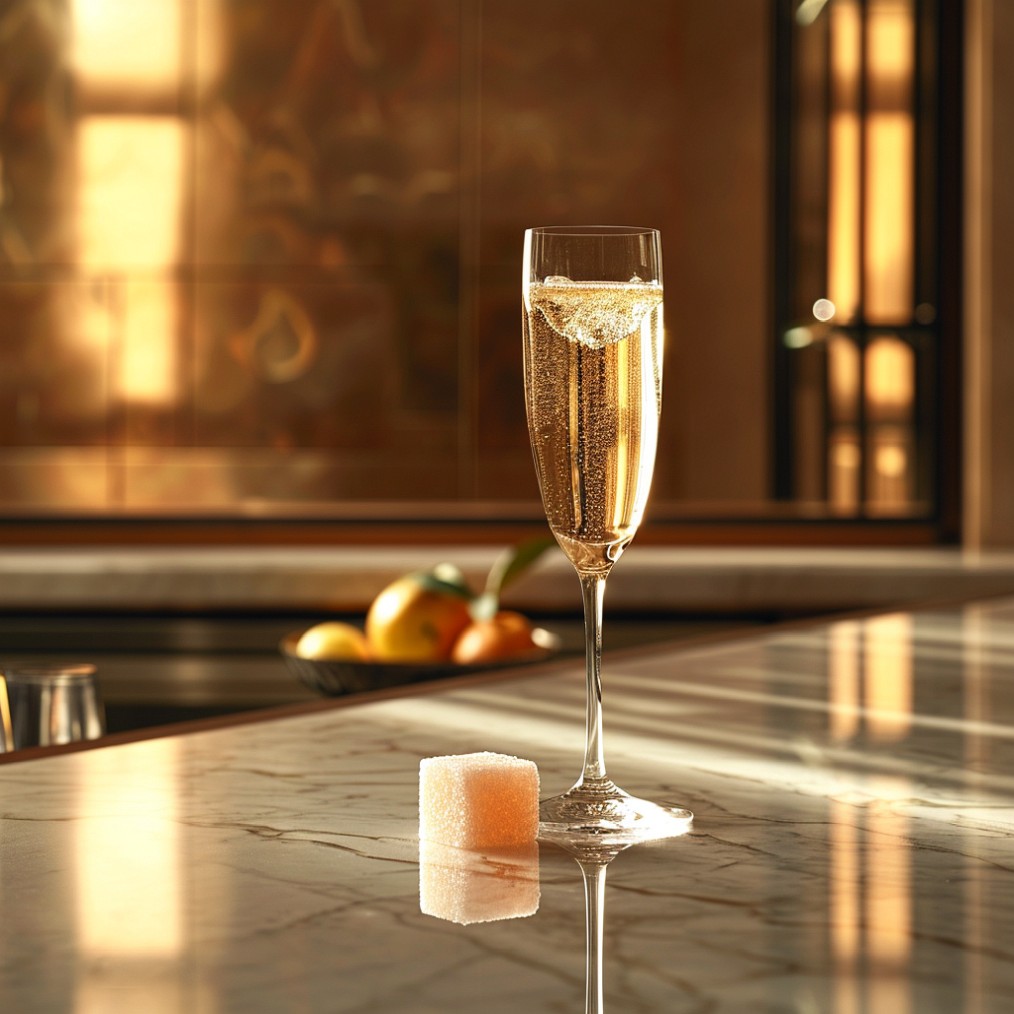
📋 Nutrition Facts
Main Alcohol Champagne
Alcohol 12%
Calories 150 calories
Fat 0g
Protein 0g
Carbohydrates 5g
Prep time 5 minutes
Champagne Cocktails are a delightful mix of bubbly Champagne with a hint of sweetness and a twist of citrus. In this article, we’ll explore its vibrant history, tantalizing taste, and how to craft this classic with finesse. Get ready to pop the cork and pour yourself into the world of Champagne Cocktails! ⬇️
History
The Champagne Cocktail is a timeless classic that dates back to the mid-19th century. It gained popularity as a symbol of celebration and luxury. This cocktail has graced the most elegant of events and the pages of renowned literature.
- The term “Champagne Cocktail” first appeared in print in 1855.
- It was a favorite among the upper class during the Victorian era.
- This cocktail has been featured in famous novels, often associated with sophistication.
The taste of a Champagne Cocktail?
A Champagne Cocktail tastes like a celebration in a glass—bubbly, with a perfect balance of sweetness and a hint of citrus zest. It’s a drink that dances on your palate and leaves you wanting more.
I personally love drinking Champagne Cocktails because they’re incredibly refreshing, especially on a hot day.
Interesting facts about Champagne Cocktail
- Adding a sugar cube soaked in bitters to Champagne was once seen as scandalous.
- It’s one of the oldest cocktails to feature sparkling wine as a main ingredient.
- The cocktail’s simplicity has made it a canvas for countless variations over the years.
Ingredients
- Champagne: 4 oz (120ml)
- Cognac: 0.5 oz (15ml)
- Angostura Bitters: 2 dashes
- Sugar Cube: 1
- Lemon Twist: for garnish
Champagne flute is the best glass to use for serving a Champagne Cocktail. The tall and narrow shape amplifies the effervescence and aroma of the Champagne. An alternative, coupe glass, can also be suitable, offering a broad surface for the bubbles to frolic.
Recipe. How to make Champagne Cocktail
- Place a sugar cube in a Champagne flute and saturate with Angostura bitters.
- Add 0.5 oz of cognac to the glass.
- Fill the rest of the glass with Champagne and watch it fizz up.
- Garnish with a lemon twist to introduce a citrus aroma.
Champagne Cocktails can be sweet, but you can swap the sugar cube for a natural sweetener to cut down on calories. The antioxidants in the Champagne and the digestive aid from the bitters add a touch of health benefits amidst the indulgence.
Food Pairings
The effervescence and acidity of a Champagne Cocktail cut through rich and savory flavors, making it a versatile pairing with a variety of dishes.
Oysters
The briny freshness of oysters complements the crispness of the Champagne, making each sip as invigorating as the sea.
Charcuterie
A selection of cured meats and strong cheeses finds its match in the bubbly zest of this cocktail, balancing saltiness with a touch of sweetness.
Dark Chocolate
The subtle bitterness of dark chocolate pairs beautifully with the sweet and tangy notes of the Champagne Cocktail.
I find the Champagne Cocktail utterly delightful—the way the bubbles tickle the nose and the sweetness mingles with the slight bite of the bitters is simply enchanting.
🍸 Mix up your beverage routine
Receive the freshest cocktail recipes and bar trends directly in your inbox.
Bartender Advice
- Always use a chilled flute to keep the Champagne Cocktail cold and refreshing.
- Experiment with different bitters to add a unique twist to the classic flavor.
- Pour the Champagne slowly over the back of a spoon to preserve the bubbles for a more effervescent experience.
Now that you’ve mastered the classic Champagne Cocktail, in the sections below we’ll shake things up by showing the customizable elements you can alter and introducing a range of exciting variations to try in your next concoction.
What you could change in Champagne Cocktail
- Champagne: Can be replaced with Prosecco for a fruitier flavor.
- Cognac: Swap with brandy to alter the depth of the spirits’ profile.
- Bitters: Experiment with orange or lavender bitters for a different aromatic experience.
Champagne Cocktail Variations
French 75
- Ingredients: Gin, Lemon Juice, Simple Syrup, Champagne.
- Recipe: Shake gin, lemon juice, and simple syrup, pour into a glass, and top with Champagne.
Bellini
- Ingredients: Peach Purée, Prosecco.
- Recipe: Mix peach purée with Prosecco in a flute and serve chilled.
Mimosa
- Ingredients: Orange Juice, Champagne.
- Recipe: Combine equal parts orange juice and Champagne in a flute glass.
For those who prefer non-alcoholic beverages, a Virgin Champagne Cocktail can be delightful. Simply replace the Champagne with sparkling grape juice and omit the cognac. Add a dash of bitters if desired, garnish with a twist, and enjoy.
Q&A
What’s the best Champagne to use in a Champagne Cocktail?
A dry or brut Champagne works wonders, balancing the sweetness of the sugar and the tang of the bitters.
Can I make a Champagne Cocktail in advance?
It’s best enjoyed freshly made to savor the effervescence, but you can prep the sugar and bitters ahead.
Is it necessary to use Angostura bitters?
While traditional, feel free to explore other bitters for exciting flavor variations.
How can I make my Champagne Cocktail sweeter?
Add more sugar or a splash of simple syrup, but remember, balance is key.
Are there any non-alcoholic bitters for a virgin version?
Yes, there are non-alcoholic bitters available that mimic the flavor without the alcohol content.
What are some common mistakes when making a Champagne Cocktail?
Overpouring the cognac or Champagne can overwhelm the delicate balance, so measure carefully.